Learning that you may have polyps or fibroids can feel a little scary. Unknown growths tend to take our minds to the worst possible scenarios. We hope to dispel some of the unknowns around these uterine growths to empower you and offer reassurance through knowledge. Polyps and fibroids are similar uterine growths, but they are made up of distinct tissues and may be associated with different symptoms and prognoses.1,2 Whereas fibroids tend to be completely benign (harmless), a small portion of polyps have abnormal or cancerous characteristics.2
Polyps and fibroids do occur together at times. A recent study found that the prevalence of co-occurring polyps and fibroids was just over 20%.3 Female hormones are implicated in both types of growth, though their precise role is not fully understood.1,2 It is estimated that 1 in 5 women experience fibroids who are of childbearing age. Let’s look at what polyps and fibroids are, how to tell if you have them, and how they are typically treated.
What are polyps?
Polyps are overgrowths from endometrial glands that range in size and stick out into the uterine cavity.2 While some are extremely small, as tiny as 5 millimeters, some are so big that they fill the entire uterine cavity.4
These polyps are non-cancerous and can occur in women of reproductive age as well as in menopausal women. Polyps are relatively common and may go undiscovered if they cause no symptoms. However, polyps may be identified if symptoms arise.2 The most common symptom of polyps is heavy bleeding, which often occurs during menstruation.5

Research has shown that polyps are implicated in about half of all patients who report heavy bleeding from the uterus.6 5 At the same time, of the women diagnosed with endometrial polyp, nearly 70% experience heavy bleeding during menstruation.7
Polyps are also associated with infertility, and about 1% may be or become cancerous.8,9
Even though most polyps are benign, it is important to check with your health care provider because they can cause reproductive issues like miscarriage and infertility.
What are fibroids?
Uterine fibroids are common, non-cancerous tumors that often go unnoticed unless they impact a woman’s menstrual cycle or cause pelvic symptoms such as pressure or pain.1 These tumors occur in 20 to 40% of women during their reproductive years.10,11 Fibroids are almost always non-cancerous, but on rare occasions, about 1%, they can become cancerous.
While the specific reasons that people develop fibroids are not completely clear, research has shown that certain factors may increase the risk for this type of uterine growth. These factors include:
- Getting your first period at an early age12
- Having no history of pregnancy13,14
- Consuming large amounts of caffeine or alcohol15,16

Symptoms of Polyps and Fibroids
There are certain symptoms associated with having polyps and fibroids that can help clue you into what is going on in your body. Sometimes polyps and fibroids go unnoticed, with minimal to no symptoms, but oftentimes there are some symptoms to watch out for. Some of those symptoms include:
- Both polyps and fibroids can cause prolonged or heavy bleeding during or in between menstrual cycles.
- Fibroids can cause pain or pressure during intercourse, and polyps can cause bleeding after.
- Abdominal or pelvic cramping.
- Low back pain.
- Miscarriage or infertility.
- Polyps can cause vaginal bleeding after menopause.
If polyps or fibroids are suspected, a healthcare provider may suggest an ultrasound to determine if either of these types of growths is present in the uterus.1,2 Ultrasound is a go-to technique for diagnosis because the technology is accessible and relatively low cost.17 Ultrasounds are minimally invasive and involve moving a device over parts of the body. In the case of polyps, ultrasound usually occurs over the vagina, whereas for fibroids the ultrasound may be over the vagina or the abdomen.1,2 With fibroids, however, some argue that both vaginal and abdomen ultrasounds should be performed to increase the chances of finding fibroids.1
There are other diagnostic techniques for identifying both fibroids and polyps, and the specific technique that is used will depend on several factors. Magnetic resonance imaging – better known as MRI – is, for instance, another common method for diagnosing fibroids. Though this approach is more expensive, it is more useful for identifying some fibroids.18
How are polyps and fibroids treated?
Several things are considered in the treatment of polyps and fibroids, and those factors will be incorporated into a treatment plan:1,19 Some of the factors considered are:
- Nature and severity of symptoms
- Location of growth
- Size of growth
- Age of patient
- Patient preferences
Depending on the goals associated with treatment, one of several approaches will be selected. The approach could be to simply monitor the growth, to intervene with medications, or to perform a procedure.1,2
A minimally invasive procedure known as uterine artery embolization – or UAE – is a well-established way to address fibroids while sparing the uterus and preserving fertility.1 Innovative ultrasound waves and radio frequency techniques also add to the arsenal of options for addressing problematic fibroid. In some cases, full surgeries may be performed to remove tissue.
In the case of polyps, the gold standard technique for removal is known as hysteroscopy.20 When a patient with polyps also suffers from fertility challenges, hormone treatment may be used.21,22
Takeaway
Although fibroids and polyps can cause a variety of uncomfortable, unpleasant, and even painful symptoms, there are treatments available to ensure that you can use the least invasive routes first to address the issue. Know that you are not alone in this experience, and there are people and healthcare professionals available to support you.
Take the Quiz or Follow us on social to meet other women exploring the same issues as you.




















